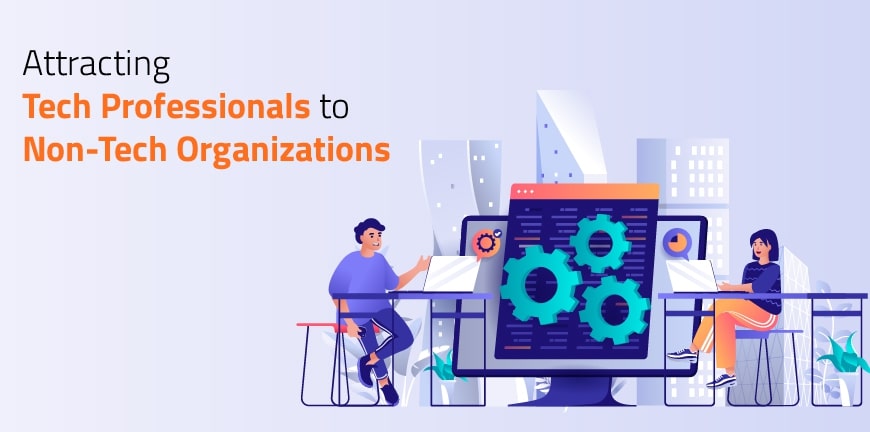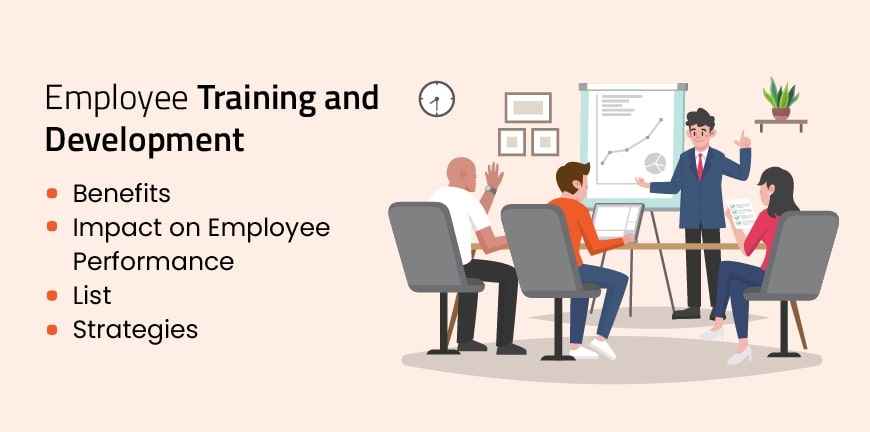
Embracing Neurodiversity at the Workplace
31/08/2023
Attracting Tech Professionals to Non-Tech Organizations
04/09/2023- What is Employee Training and Development?
- Benefits of Employee Training & Development Programs
- Impact of Training and Development on Employee Performance
- List of Training Programs for Employee Development
- Training and Development Strategies for Employee Growth
- Difference between employee training and management development
- Looking for a training and development partner?
How do you ensure that every employee in your workforce is working to the best of their ability and are aware of their role and responsibilities? Employee training and development is crucial to proper workforce management. It helps ensure that the knowledge transfer from an expert, the application of acquired skills at the workplace, and the peer and mentor-based learning processes happen smoothly. Let us now look at the definition of employee training and development.
What is Employee Training and Development?
Employee training and development involves the acquisition of specific knowledge or skills by employees that will help them in their current or future roles designated by the company. These skills are not restricted to just technical but include soft skills and people management skills as well.
Benefits of Employee Training & Development Programs
Did you know that as high as 70% of employees are willing to leave a company for another that is willing to invest more time in training and development programs for employees? There are several benefits to employee training and development programs. Let us look at some of these benefits in some detail now:
1. Increase productivity
Operational and strategic level training can help improve the understanding of the job role and their productivity levels will improve and their error rates will be lowered. They also stay current with newly developed tools which again will contribute to a rapid increase in productivity.
2. Increased customer satisfaction
Well executed processes lead to increase in product or service quality, which then ensures a great customer feedback every time they go for one. Thus, employee training and development directly impacts the level of customer satisfaction.
3. Increase in safety
The more frequently training and development programs are held, the more assurance of safety is there for the teams that are undertaking operational tasks that require greater attention and care.
4. Increase in cross-training development
Cross-training can happen more frequently with the training and development programs, as those who are already trained will be able to train others in their teams or their organisations, leading to further growth and development.
Impact of Training and Development on Employee Performance
The impact of training and development programs for employees on their performance is palpable. Some of the significant changes brought about by training and development in employee performance are increased productivity and reduced errors and hence improved quality of work.
Employee performance reviews are a testament to how good training and development programs can be for employee success at the workplace. Employee training and development programs can also improve employee engagement and may even have a positive impact on their lives, restoring a healthy work-life balance, if employees are trained on how to achieve it.
List of Training Programs for Employee Development
When it comes to training, as high as 80% of employees believe that regular and frequent training is very important. But an employee requires a different type of training at different stages in his career. Some of these types of training and development programs are:
1. Onboarding training
In onboarding training, the employee is trained on how to manage the day-to-day work that they must do. It also includes the necessary communication and other soft skills they must master to ensure that they fit into the new workplace.
2. Leadership training
Training leaders is key to organisational success. For this reason, organisations must invest time in training employees to be managers and managers to be leaders, providing mentorship to them at their early stages in the organisation if they have the necessary skills. Give them the autonomy to manage stress as ably as they can.
3. Compliance training
Informing employees of the organisation’s regulations, policies or adherence to laws is called compliance training. These policies could be both internal corporate policies they must conform to or statutory policies that they must follow.
4. Safety training
Want to save employees from unnecessary injury and abuse? Safety training is crucial to ensuring that employees are well aware of how to conduct themselves safely at the workplace. The safety training at the workplace can include workplace ergonomics training, prevention of abuse at the workplace, fire safety techniques and other employee health resources.
5. Managerial training
Managing others at the workplace requires great skill. As the famous saying goes, “While leaders do the right thing, managers do things right!” A manager’s job is about managing resources effectively, delegating to the right extent, being accountable and mentor the employees if need be. They must be trained on social emotional management at the workplace too.
Training and Development Strategies for Employee Growth
A game of football without a clear plan of execution will suffer even if every player on the team is genuinely talented. The same goes for workplace training and development programs also. If your training and development program is not driven by well thought-out strategies, it will be akin to shooting in the dark, you will not achieve your business goals. Here are some employee development training ideas.
1. Encourage self-direction in learning
You cannot have motivation if it does not come from within. Sometimes you know what’s right, but your employees must agree too. Employees decide how they want to progress in their career, so the learning must also be by their choice. AI-based learning tools can help identify what skill gaps exist and how to address them based on the inputs they receive and the interactions with the employees.
Content tagging can recommend relevant and personalized content and an LMS can help auto-enroll employees in learning pathways that are beneficial to them. Link the content in the learning pathway to business objectives for greater benefits.
2. Use an on-demand strategy
Have a vetted catalogue of content ready for the employee to access. If you can build a knowledge base for employee training, that would be a game-changer for everyone in your office. If this knowledge base is always available and online, then it would be even more convenient as it will allow employees to work from home as well.
3. Introduce microlearning
A study by Deloitte revealed that the average worker has only 24 minutes to devote to learning a week. Micro-learning uses infographics, short videos and recording etc. to deliver useful content that will assist in their jobs.
Use one short video or recording to focus on a single topic. Covering multiple topics in the span of a few minutes is not advisable and does not end up being a good use of the employee’s training time.
4. Offer immersive learning programs
Once the skills have been acquired, they need to be applied too, and it must be possible for employers to test the waters and see if the training has worked.
Immersive learning can help with this. Use case studies or client experience videos to help employees understand the real-world application of the skills they have acquired.
You can also use VR, which is very engaging and tech-enabled type of training that can deliver lifelike experiences and problem-solving spaces for your employees. The level to which trainees will engage with the training will depend on how close it is to real-world conditions.
The 70/20/10 model of learning postulates that 70% of learning happens through on-the-job experiences (experiential learning), 20% through social interactions with peers and mentors and only 10% through a formal course. Immersive learning helps bring the same benefits of experiential learning to each employee.
5. Gamify learning pathways
What do employees like the most in a workplace that they would share with others? A celebration of their achievements. By adding gamifying elements to learning pathways, you can make it more competitive for employees even when they are training, urging them to go for higher goals.
Some ways to introduce gamification in the learning pathway for each employee is to introduce a point and ranking system, with a leader board, and the possibility to earn badges for every achievement and the freedom to share their achievements and these badges online. While adding gaming elements always also analyse the psychological impact of introducing them.
6. Optimize post-training evaluations
Your training program cannot remain the same, it needs to improve. For this post training evaluations become essential.
Once each round of training is completed, conduct a survey where you ask both open-ended as well as other questions to determine whether the training program is achieving its goals from the employee’s perspective.
You can even use AI-based training evaluation tools for gaining insights into actual performance improvement and how much of that can be correlated to the training that was imparted.
7. Create a learning culture
Everyone at the workplace must be open to learning, and learning itself must be seen as a way of improvement rather than a sign of weakness. For this, managers must participate in training and development programs for employees, not only assisting in its creation but actively becoming learners too. It requires buy-in from the top leadership too who can sanction the allocation of funds for it.
Devoting as much as 20% of the time in the workplace to continuous learning could be very rewarding for the business as employees learn new skills, apply them and solve problems faster. The overall time reduction would justify the time spent on learning. The learning can be linked to performance reviews too, where you recommend a certain learning pathway following a review.
Difference between employee training and management development
In employee training, typically the employee is trained to improve his/her skills at what they are doing currently. In management development, the employee is trained to move to a managerial level. The employee will have to undergo additional skills-based training, emotional intelligence training and training for leadership.
Looking for a training and development partner?
A training and development partner can help design and administer an employee training and development program that will help your employees develop necessary skills and emotional temperament to help them meet the challenges at the workplace. With over 25 years of HR consulting experience which includes training and development program administration for employees in several Fortune 500 companies, Alp Consulting is best suited to assist you for your training and development needs. Talk to us today.




